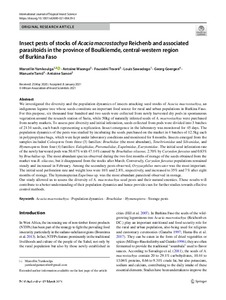| dc.contributor.author | Yamkoulga, M. |
| dc.contributor.author | Waongo, A. |
| dc.contributor.author | Traore, F. |
| dc.contributor.author | Sawadogo, L. |
| dc.contributor.author | Goergen, G. |
| dc.contributor.author | Tamo, M. |
| dc.contributor.author | Sanon, A. |
| dc.date.accessioned | 2021-06-21T10:41:16Z |
| dc.date.available | 2021-06-21T10:41:16Z |
| dc.date.issued | 2021 |
| dc.identifier.citation | Yamkoulga, M., Waongo, A., Traore, F., Sawadogo, L., Goergen, G., Tamo, M. & Sanon, A. (2021). Insect pests of stocks of Acacia macrostachya Reichenb and associated parasitoids in the province of Boulkiemde, central-western region of Burkina Faso. International Journal of Tropical Insect Science, 1-10. |
| dc.identifier.issn | 1742-7584 |
| dc.identifier.uri | https://hdl.handle.net/20.500.12478/7138 |
| dc.description.abstract | We investigated the diversity and the population dynamics of insects attacking seed stocks of Acacia macrostachya, an indigenous legume tree whose seeds constitute an important food source for rural and urban populations in Burkina Faso. For this purpose, six thousand four hundred and two seeds were collected from newly harvested dry pods in spontaneous vegetation around the research station of Saria, while 50kg of naturally infested seeds of A. macrostachya were purchased from nearby markets. To assess pest diversity and initial infestation, seeds collected from pods were divided into 3 batches of 2134 seeds, each batch representing a replication. Insect emergence in the laboratory was monitored for 45 days. The population dynamics of the pests was studied by incubating the seeds purchased on the market in 4 batches of 12.5kg each in polypropylene bags, which were kept under laboratory conditions and monitored for 8 months. Insects emerged from the samples included Coleoptera from three (3) families: Bruchidae (the most abundant), Tenebrionidae and Silvanidae, and Hymenoptera from four (4) families: Eulophidae, Pteromalidae, Eupelmidae, Eurytomidae. The initial seed infestation rate of the newly harvested pods was 50.67% with 47.14% caused by Bruchidius silaceus, 2.70% by Caryedon furcatus and 0.83% by Bruchidius sp. The most abundant species observed during the two first months of storage of the seeds obtained from the market was B. silaceus, but it disappeared from the stocks after March. Conversely, Caryedon furcatus populations remained steady and increased in February. Among the secondary pests observed, Oryzaephilus mercator was the most important. The initial seed perforation rate and weight loss were 16% and 2.8%, respectively, and increased to 35% and 7% after eight months of storage. The hymenopteran Eupelmus sp. was the most abundant parasitoid observed in storage. Our study allowed us to assess the diversity of A. macrostachya seed pests and their natural enemies. These results will contribute to a better understanding of their population dynamics and hence provide cues for further studies towards effective control methods. |
| dc.format.extent | 1-10 |
| dc.language.iso | en |
| dc.subject | Pest Insects |
| dc.subject | Population Dynamics |
| dc.subject | Bruchidae |
| dc.subject | Hymenoptera |
| dc.subject | Burkina Faso |
| dc.title | Insect pests of stocks of Acacia macrostachya Reichenb and associated parasitoids in the province of Boulkiemde, central‑western region of Burkina Faso |
| dc.type | Journal Article |
| cg.contributor.affiliation | Institut de l’Environnement et de Recherches Agricoles, Burkina Faso |
| cg.contributor.affiliation | Université Joseph KI-ZERBO |
| cg.contributor.affiliation | International Institute of Tropical Agriculture |
| cg.coverage.region | Africa |
| cg.coverage.region | West Africa |
| cg.coverage.country | Burkina Faso (Upper Volta) |
| cg.coverage.hub | Headquarters and Western Africa Hub |
| cg.researchtheme | Plant Production and Health |
| cg.identifier.bibtexciteid | YAMKOULGA:2021 |
| cg.isijournal | ISI Journal |
| cg.authorship.types | CGIAR and developing country institute |
| cg.iitasubject | Agronomy |
| cg.iitasubject | Pests of Plants |
| cg.iitasubject | Plant Breeding |
| cg.iitasubject | Plant Health |
| cg.iitasubject | Plant Production |
| cg.journal | International Journal of Tropical Insect Science |
| cg.accessibilitystatus | Limited Access |
| cg.reviewstatus | Peer Review |
| cg.usagerightslicense | Copyrighted; all rights reserved |
| cg.targetaudience | Scientists |
| cg.identifier.doi | https://dx.doi.org/10.1007/s42690-021-00429-3 |
| cg.iitaauthor.identifier | Georg Goergen: 0000-0003-4496-0495 |
| cg.iitaauthor.identifier | Manuele Tamò: 0000-0002-5863-7421 |
| cg.futureupdate.required | No |

